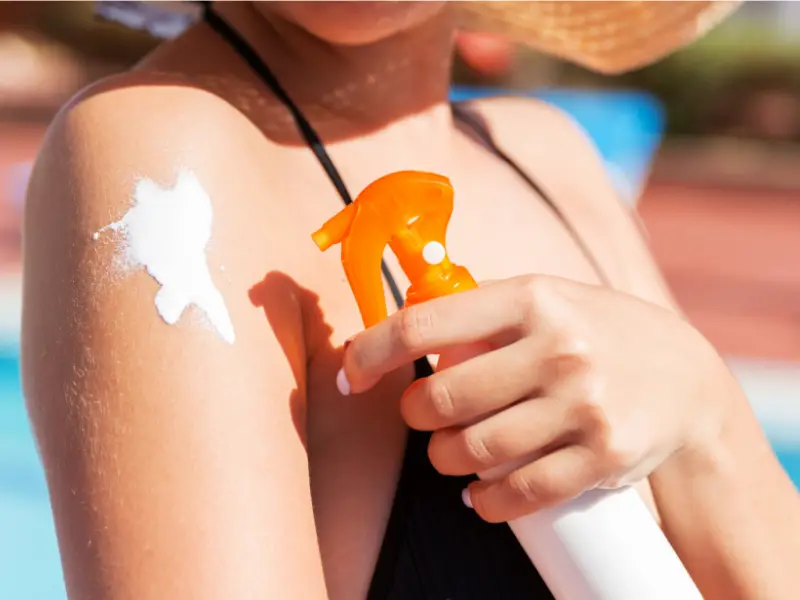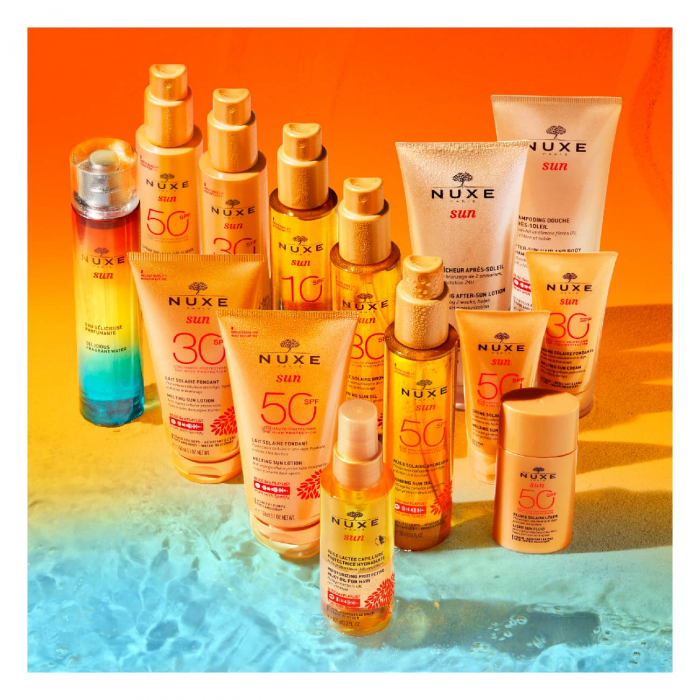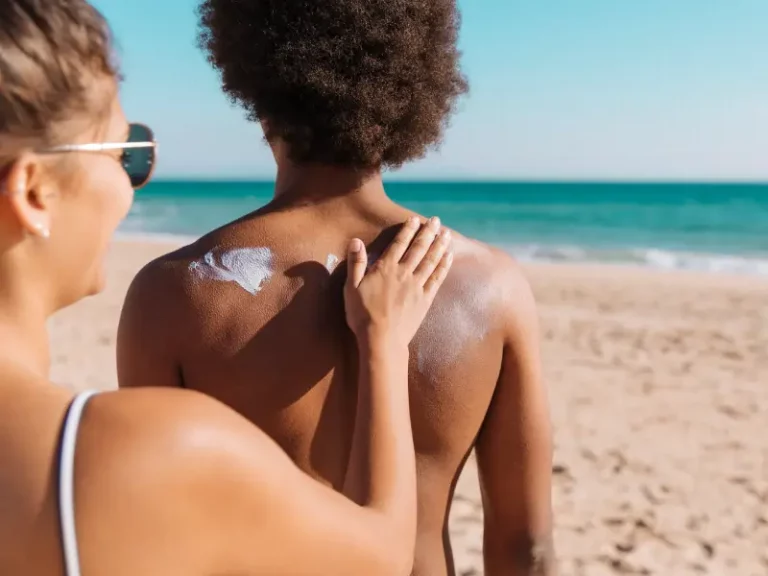Table of Contents
Embarking on a journey to demystify a common question: Does sunscreen prevent tanning?
As the sun graces us with its warmth, the desire for a golden glow often clashes with the need for skin protection. Join us in this insightful blog as we delve into the science behind sunscreen, exploring its effectiveness in shielding your skin from harmful UV rays while navigating the nuanced relationship between sunscreen and that sought-after sun-kissed tan.
Stay informed, stay protected, and let’s debunk the myths surrounding sunscreen and tanning for a radiant and healthy summer glow.
Does sunscreen prevent tanning?
No, it does not.
Chemical-based sunscreen works by absorbing UV rays and altering them before they penetrate the skin and cause damage. Mineral sunscreen, on the other hand, reflects the rays away from the skin.
Either way, no sunscreen can protect your skin from the sun 100%.
What are the different SPF levels and their impact on tanning?
SPF, Sun Protection Factor, is a measurement of how long we can stay out in the sun without getting burned, based on our skin type.
For example, if your skin usually burns in 10 minutes, using a sunscreen SPF30 means you can stay in the sun for 30 times longer without getting a sunburn, which means, for 300 minutes, in this case. Of course, this depends on how you apply the sunscreen!
So, SPF 30 usually blocks 97% of UV rays, while a sunscreen SPF 50 blocks 98%. This means, that even when wearing sunscreen, your skin is still receiving UV radiation and, therefore, tanning.
What are the risks of tanning without sunscreen?
People tan when UVA radiation comes in contact with the skin. Once the UV rays penetrate the lower layers of the epidermis, cells begin to produce melanin. But UVA and UVB rays are very harmful to our skin in several ways:
- Sunburn: Unprotected exposure can cause painful sunburn, characterized by redness, swelling, and blistering.
- Premature aging: UV rays accelerate the aging process, leading to wrinkles, fine lines, and sagging skin.
- Skin damage: Prolonged sun exposure damages the skin’s DNA, increasing the risk of skin cancer, including melanoma.
- Hyperpigmentation: Tanning can cause uneven skin tone, dark spots, and hyperpigmentation, especially in sun-exposed areas.
- Weakened immune system: Excessive UV exposure weakens the skin’s immune system, making it more susceptible to infections and diseases.
- Allergic Reactions: Some individuals may develop photosensitivity or allergic reactions to the sun, leading to rashes or other skin issues.
Read also: The best sunscreens for hyperpigmentation

Tips for achieving a beautiful tan with sunscreen
You can achieve a beautiful tan through the use of sunscreen for healthy skin, and more conveniently. A healthy tan is possible and good for your skin with the use of sunscreen, too. Observe the following precepts and you will obtain that sun-kissed glow, safely:
Select the correct sunscreen
Choose a more effective and pleasing sunscreen. Choose one with a broad spectrum of protection.
The increased effect of the good SPF for your skin type look better in the overall balance of complexion, enhances its resilience, and works on already damaged skin. Look for products that do likewise with UVA and UVB.
Put on a large amount of sunscreen
To ensure an adequate level of protection, wear plenty of sunscreen and spread it methodically over your skin. Included in your coverage should be often neglected areas such as the ears, neck, and tops of feet.
Apply it frequently
Reapply a suncare product every two hours or more often if you are swimming or sweating. Maintaining consistent coverage guarantees continued protection from harmful UV rays while you are tanning your skin.
Gradually build it up
Begin with limited sunlight exposure and gradually increase to longer periods. By doing this, you won’t scorch your skin but rather help it adapt to the sun and become tanned.
Time your exposure
Tan in the early morning, or late afternoon when the sun’s rays are weaker. Avoid the peak hours between 11 a.m. and 4 p.m., when the risk of sunburn is highest.
Use protective clothing
Wear lightweight long-sleeved clothing and a wide-brimmed hat to shield your skin from direct sunlight. This prevents overexposure so you need less sunscreen.
Stay hydrated
Proper hydration is important for healthy skin. Drink enough water to hydrate your skin from the inside out.
Moisturize
Keep your skin moisturized by using a face moisturizer, a body hydrating lotion, or after-sun product. This will help extend your tan and prevent dryness.
Exfoliate
Before tanning, gently exfoliate your skin to remove dead skin cells. This ensures a nice even tan and more thorough absorption of the sunscreen.
Explore our range
Face exfoliators
Body scrubs and exfoliants
Protect your eyes
UV sunglasses give you full protection from ultraviolet rays. This way, your eyes won’t get any damage from sunlight.
Final Note
One more thing, a beautiful tan doesn’t require sacrificing skin health. Prioritize responsible sun exposure, and you can enjoy a radiant glow while safeguarding your skin from potential harm.
How to Tan in a healthy way
The healthiest way of getting a tan is actually to get a fake tan. Nowadays, there are numerous self-tanners for face and body self-tanning products, each offering a different application method and result.
This includes self-tanning lotions, creams, mousses, or even wipes, gradual tanning products tanning drops, and instant tanning sprays.
Most of these products contain self-tanning ingredients, such as DHA (dihydroxyacetone), which reacts with the amino acids in the top layer of the skin to produce a tan.
To enhance your tanning you can also take tanning supplements, which accelerate the tanning process and prolong its results.
But remember, these products don’t contain sun protection, so you should still wear sunscreen every day, regardless of the weather.
It is recommended to apply sunscreen 30 minutes before going outside to ensure that it has fully bonded to the skin.
Reapplying every two hours or more often when out in the sun is also essential.

FAQs
Can you tan with sunscreen?
Yes, you can. Sunscreen doesn’t block all the UV rays.
Is it possible to get a sunburn while using sunscreen?
Yes! You can still get sunburned while using sunscreen, so be careful not to stay in the sun for too long, avoid the hours with the highest solar index (between 11 AM and 4 PM), and reapply your sunscreen.
How often should you reapply sunscreen while tanning?
Generally speaking, you should reapply sunscreen every two hours. But consider sunscreen type and activities. Going in the water or engaging in some physical activities causes the sunscreen to wear off faster. Sprays can also be tricky, so be generous when applying a spray sunscreen.
Can you tan with SPF50+ sunscreen?
Yes! Even SPF50+ lets some UV rays penetrate the skin, which means you will still tan, just a little slower.
What are the best self-tanning products?
Comodynes Self-Tanning The Juicy Glow Serum, Nuxe Sun Hydrating Enhancing Self-Tanning Cream, and Lancaster Sun 365 Instant Self Tanning Jelly are some of the best self-tanners.
What are the best tanning supplements?
Lierac Sunissime Tanning Capsules, Oenobiol Self-Tanner Capsules, and Nutreov Sunsublim Self-Tanner Capsules are all great tanning supplement options.
Can you still absorb vitamin D with sunscreen on?
Yes, you can. Some people also believe that wearing sunscreen might prevent them from absorbing vitamin D, an important vitamin for our body.
But that is not the case. Those small amounts of UV rays that sunscreen lets through are more than enough to maintain good levels of vitamin D.
Conclusion
Remember that beauty trends come and go and tanned skin may be considered beautiful, but there’s no trend as timeless as healthy skin.
Protecting your skin is a smart and responsible approach to enjoying the sun without compromising your skin’s well-being.
Plus, you will prevent premature aging and maintain youthful, glowing skin.
